Tom Mason has been working as a professional writer in the entertainment field for awhile now, before that, Malibu Comics. But, before that, there was…Radion!

Radion 6: August, 1977
Editor and publisher: Tom Mason

I have focused many times on artists who cut their teeth in the fanzine world, but with this entry, we see the beginnings of a professional writer, namely Tom Mason. Tom was definitely a reader of variety even way back then. He has 3 interviews in this issue, two of which he conducted himself. The subject matter runs the gamut, from the newspaper strip Funky Winkerbean (creator Tom Batiuk is interviewed by Bob Sparks) to fantasy art (Michael Whelan interview) to science fiction novels (Ron Goulart interview). Sprinkled throughout are illustrations from some of fandom’s real workhorses. I believe Interfan (a group of fans banded together to help each other get their work in zines) was in the very early stages at this point, if actually formed at all). One of it’s members, Doug Hazlewood, sent editor Mason a group of illustrations, many of which were done by Interfan members. Doug Herring contributed several pieces, in addition to writing an article on the Marvel comic, The Eternals. You can see a variety of his work below.


As I said, Doug Hazlewood (who would go on to do a slew of inking work for Marvel, DC, Fleetway, and Eclipse) had a lot of work in this zine himself. Doug recalls the impetus for the flood of work below.
My main memory is that I was frustrated with only having an illustration or two in various fanzines per issue. That was mostly my own fault for not being the most motivated person and also because it was hard to come up with ink-worthy pencils of my own. I always wanted to get right to the inking and pencilling was a chore and I hated swiping too much.
I loved corresponding with Tom Mason (I used to write long letters to my regular correspondents) and it was his idea for meto ink some pro sketches and to do the Funky Winkerbean illustration. I loved seeing my work in print and it was inspiring. Though sometimes it could be embarrassing a few years later or bad print jobs could break your heart when you got your free copy (or copies). Radion was one of the best outlets I could find at the time.
It may have been the next issue or so where the print job was sub-par and I feel like I mentioned it too much, as Tom didn’t personally print the zine. I was taking printing classes at college at it bothered me that the printer didn’t do a better job for Tom. The previous issues looked fine and later I thought I might have made Tom feel bad about it. My wife always mentions how I tend to “go on” about things.
I valued our ‘pen pal’ friendship and his efforts and still have fond memories of my fan days. We had no internet back then and I typed many a letter. Time seemed to go much slower and it just zooms by now. It was so cool to see your work in print and to have multiple illustrations in one issue!
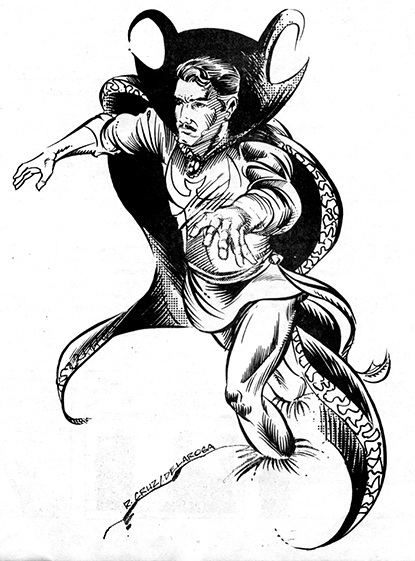 The illustration above (of John Byrne and Roger Stern’s funny robot character, Rog-2000) was penciled by Carl Taylor, another Interfan alumni whose work seemed to be everywhere. Carl talks (via Facebook) about the process usually used in Interfan and this illo in particular, saying “I used to communicate with Tom Mason directly back then, so I probably got Hazlewood to ink this & sent it to him…the ones I sent Sam which he forwarded generally, were inked by him. Some pencils also were sent to whomever was heading Interfan (Jim Bertges or Doc Boucher) at the time.” Inker Hazlewood also did a spot illustration of Funky Winkerbean to start off the first feature of this issue, the Tom Batiuk interview. You didn’t see much coverage of pure strip creators like Batiuk in the comic fanzines of this time, so this was a nice treat.
The illustration above (of John Byrne and Roger Stern’s funny robot character, Rog-2000) was penciled by Carl Taylor, another Interfan alumni whose work seemed to be everywhere. Carl talks (via Facebook) about the process usually used in Interfan and this illo in particular, saying “I used to communicate with Tom Mason directly back then, so I probably got Hazlewood to ink this & sent it to him…the ones I sent Sam which he forwarded generally, were inked by him. Some pencils also were sent to whomever was heading Interfan (Jim Bertges or Doc Boucher) at the time.” Inker Hazlewood also did a spot illustration of Funky Winkerbean to start off the first feature of this issue, the Tom Batiuk interview. You didn’t see much coverage of pure strip creators like Batiuk in the comic fanzines of this time, so this was a nice treat.
The Doc Strange illustration above by Ric Cruz and Sam de la Rosa is a nicely naturalistic pose professionally inked (de la Rosa was another very prolific artist at that time and went on to ink many books by Marvel, DC, and Dark Horse). You can check out de la Rosa’s website here. Sam also inked the cover you see at top, as well as inking some Bill Neville work below.
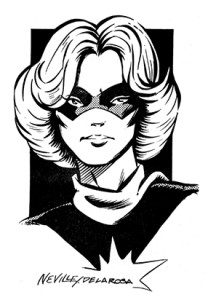
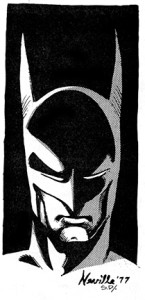 After a fanzine review feature, the second interview begins in earnest, that being Michael Whelan. Whelan is one of the acknowledged “gods” of the fantasy/sf publishing field. At the time of this fanzine, he had only been a professional a few years (in the interview, he mentions the process that got him his first book cover assignments at DAW books).
After a fanzine review feature, the second interview begins in earnest, that being Michael Whelan. Whelan is one of the acknowledged “gods” of the fantasy/sf publishing field. At the time of this fanzine, he had only been a professional a few years (in the interview, he mentions the process that got him his first book cover assignments at DAW books).
Following the Whelan interview is the Eternals article by Herring. Then we get the editorial by Mason (Blatant Self Indulgence), and that is followed by the Ron Goulart interview.
Tom was probably thrilled to see his zine hit the post each time. We all get a thrill out of getting our work published and seen by many. In my email conversations with Doug Hazlewood, he elaborates on his experience below.
I had stuff printed before and after that, but it was memorable to have that many illustrations in one issue. I think this would have been near the end of my college days. Early on it was a thing here and there or maybe two or three in one issue of something.
I had been getting stuff published in high school (and some rejected). Interfan helped put some of us artists together later on and I finally worked on a story with help from Pete Iro. I was mainly a ‘spot illustration’ guy and didn’t like doing backgrounds. My one attempt on my own at a short comic story just got shorter and shorter out of frustration. That’s when I knew for sure I’d never be a comic book penciller.
It was educational to see things in print, like my tendency to make outlines too thick due to my obsessive nature. Sometimes I actually liked the effect, but you need to have more variety in line weights (unless that’s the style you are going for). Later on when finally inking comic books I’d look at my early issues of Liberty Project and see I’d need more variety on the outlines. Sometimes you can’t see the forest for the trees until the art is reduced and printed. Even when I inked some covers for Larry Houston’s The Enforcers, I was still outlining too thick/not enough thick-to-thin on outlines and feathering.I was self-taught, so once I really started doing samples to try and break into comics I was kind of learning as I went about backgrounds, etc. And what was a waste of time to try and be to perfect with once something was printed on newsprint.I know I saw Tom at a show or two in the 90’s when all the Superman hoopla was going strong. Can’t remember if I introduced myself. I loved corresponding with Tom and Mark Heike. I saved so many letters and things I’d get in the mail. Over the years I’d gradually weed out some things (like newsprint things). You can’t save everything!
There is much more wonderful work in this zine that you can see in the pdf, by artists such as those mentioned above, as well as Willie Blyberg of Wowiekazowie (you can see columns dedicated to this zine here), Alan Weiss, Bill Black of Paragon, and a really elegant piece by Stan Sakai, seen below.
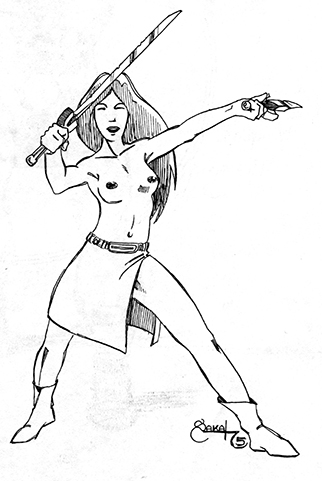
Via facebook, Stan says at this time, “I know I was in college–University of Hawaii. I was a drawing/painting major, and I took a lot of life drawing classes. That might be where the pose came from.”
Last, and certainly far from least, is editor and publisher, Tom Mason. I have known Tom somewhat via social media for awhile now, and he graciously answered a bunch of questions for me.
Q: Was Radion your zine from the start?A: Oh yeah. All mine. It originally started as The DC Reader for issues #1-3 because I grew up as a huge DC fan (and was a late-starter with Marvel). I don’t know where the Radion name came from – I just pulled it out of my head.I had no experience doing any kind of production work. It was all trial and error. Typing, paste-up, dealing with the printer, stapling and mailing. I learned “on the job” and by copying other fanzines that I’d seen.I didn’t keep track of money. I earned enough to publish 100 copies, sold as many as I could, gave away a lot, and then saved enough money to eventually print another one. I didn’t even realize that the printer could collate and staple them for me, so after I picked them up, I’d spend an evening putting each issue together by hand.Q: What time of your life was this zine started, and the same for this issue.
A: Just a kid really. The printer that I used was on the way to my orthodontist appointment.Q: What prompted you to start your own zine?A: I wish I had a definitive moment or some kind of mentor-based story, or a flash of lightning inspiration. But I’d been reading a lot of fanzines, and I just thought it would be fun to do. I liked writing, I liked putting things together, so I thought “how hard could this be?”Q: Did Radion continue beyond issue 6?6 was the last. I was getting “older” and my daily life was getting more hectic and I just ran out of time.Q: At that time, did you have any favorite fanzines? Any you liked just as a reader, any that you modeled Radion after?A: I loved all the fanzines I read, even ones that were truly crappy. I ordered them by the ton from the pages of The Buyer’s Guide for Comic Fandom. And at that stage of my life, there weren’t comic book fans in my hometown. Certainly none that I was aware of, so whatever showed up in the mail was my hangout. I loved Mike Main’s Free Fall, Roland Austin published a zine that I think was a one-shot, Jim Main was publishing, Rod Snyder out of Texas, Bill Mutschler in New Jersey, Kevin Cook was doing a Star Trek fanzine out of Georgia, Rich Morrissey’s Batmania, so many others that I’m sure will pop into my head after I send this to you. I also got The Comic Reader every month, which I’d discovered from an editorial page in the back of Vampirella.Q: How did you secure your contributors? Any stories on any particular meeting, incident, etc.?A: Ha! I never met any of them. Everything was done by mail. I’d see an artist whose work I liked, and if I found their address somewhere, I’d write to them. I would just ask them to contribute and most of them would. As I got to know other fanzine editors, we’d often swap information on contributors. It was fun.Q: In your editorial column you mention the work that Sam de la Rosa sent to you. You mention him having a sort of fanzine supply house…I assume that was Interfan…did you find that out later or were you ever aware of it?A: Sam was a great guy. I thought he had real talent and would be a star in comic books at some point. A lot of art did come from Interfan. I thought that organization was a great idea. I don’t know how I found them, but I’m sure it was from some other fanzine. I think Steve Clement was the founder, but I dealt with the guy who took it over. Every couple of months he’d send me a big envelope full of original art. I’d pick what I wanted to use and ship the rest back.
Q: How did you secure your interviews with Goulart and Whelan? Any anecdotes about either?A: I loved those guys. What usually happened is that I looked around at the stuff I was interested in. I loved Ron Goulart’s books – he had a knack for funny stories that were well-told and interesting, and his writing was “light” which is really hard to pull off well. I read everything that came out with his name on it.That also meant that I was hanging around the science fiction section of my local bookstores, which meant I saw a lot of covers painted by Whelan. Some of the books he did the covers for didn’t interest me, but the covers sure were great.So I was a fan, and one of the ways I connected, however briefly, with people like that was to interview them. That’s why James Childress, the creator of Conchy, was interviewed. I loved his work on the comic strip and just wrote to him.Years later, my path would cross with Goulart several times and I’d actually meet him, and have lunch with him. He’s a great guy, and so smart. If there was any justice, he’d be a millionaire.Q: Did working in fandom help prepare you for your career later? Did you form any really worthwhile relationships there? Keep in touch with any fandom friends?A: That’s my great failing. I probably “knew” 100 folks from that period, but it was all through the mail, and I failed to keep in touch with any of them. It was pre-internet, pre-texting, so everything was done by mail and if people moved or dropped out or went off to college or had other life changes, it was just much harder to stay in touch. And I liked them. I really enjoyed corresponding with them, reading their work, looking at their artwork. So, I was just an idiot. Some of us have found each other again via Facebook.But I had no illusions about being a fan or a fanzine publisher. I had no desire to work in comic books as a professional – which at that time meant Marvel and DC. That wasn’t on my radar at all as a goal.Q: Can you give me a breakdown of what came after your fandom work?A: I was sort of done after that. I wasn’t into comics any more, I had lost interest in mainstream comics at that time. I wasn’t buying any, I wasn’t reading them. I went to college. I started working on the school newspaper as a cartoonist and later an art director. Then I moved to the tri-state area and started working in New York as a cartoonist – mostly notably for Playboy and Cosmopolitan – and illustrator. I ended up working at Fantagraphics, which brought me into the world of alternative comics, which I discovered I liked a lot. Then when they moved to California I went with them. I met Dave Olbrich at Fantagraphics and when he left and launched Malibu Comics, he brought me in, along with Chris Ulm. Dave knew how to publish comics, Chris was a strong editor, and I knew, by then, how to make comics. After the company was sold to Marvel Comics, I walked away.After that, I thought it would be fun to write for television. So I transitioned to working in animation, writing scripts and show-running, usually with my writing partner Dan Danko who I knew from Malibu Comics. We’ve done something like 400 broadcast episodes of television and 70+ children’s books, and the occasional video game.Q: What would you consider your better achievements in fandom, and later, in your career?A: I don’t think I had any real achievement or legacy in fandom. Nothing even close. I’m always surprised when anyone brings it up. It floors me. Later achievements? I guess it depends on perspective. I’ve been able to thrive as a freelancer for quite some time without crawling back into a cubicle. I won an Emmy for my TV work, so there’s that. And I have two great kids who both show an interest in writing and drawing which thrills me.Q: What are you doing nowadays?A: I continue to write and develop TV shows. I’m doing one for Netflix right now, and I have two shows in development that are waiting for the greenlight. I write a series of children’s books for Simon & Schuster under a pseudonym. And occasionally I’ll help out my friends at Space Goat by packaging a graphic novel or three.
As I said, download the pdf to get the whole story. Thanks this time go out to Tom Mason, Doug Hazlewood and Stan Sakai.
Tune in next month for…well, another fanzine! And please, if you read, leave a comment! I’m a needy nerd.
Ken Meyer Jr.
kenmeyerjr@yahoo.com


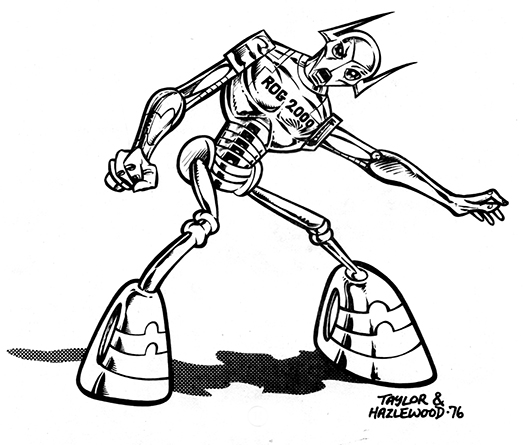
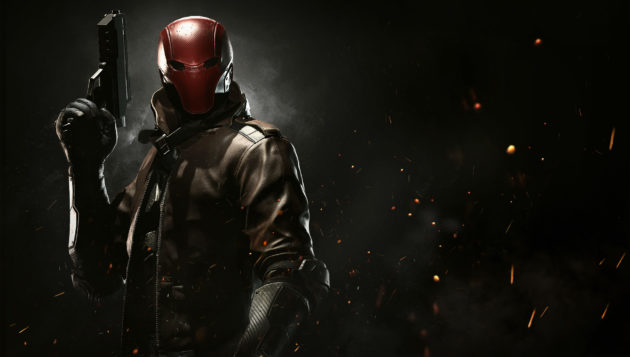
Thanks, Ken! It’s crazy to see this stuff again after all these years. And to read comments from Doug Hazlewood and the others. Doug and I had a long-running correspondence and had a lot of interests besides comics. And he was a terrific artist even back then. He’s right about the crappy printing on that one issue. I had switched print shops and that was the result and I couldn’t get them to fix it and I couldn’t fight them or afford to reprint it elsewhere. So I was just stuck. Everybody was working on volunteer terms, so the least I could do was get them decent printing, and I failed that time. Thanks for the time travel, Ken!
My pleasure, Tom, and thanks for stopping by!
Great in-depth article as usual and fun read too . Many thanks !
thanks for stopping by and leaving a comment!